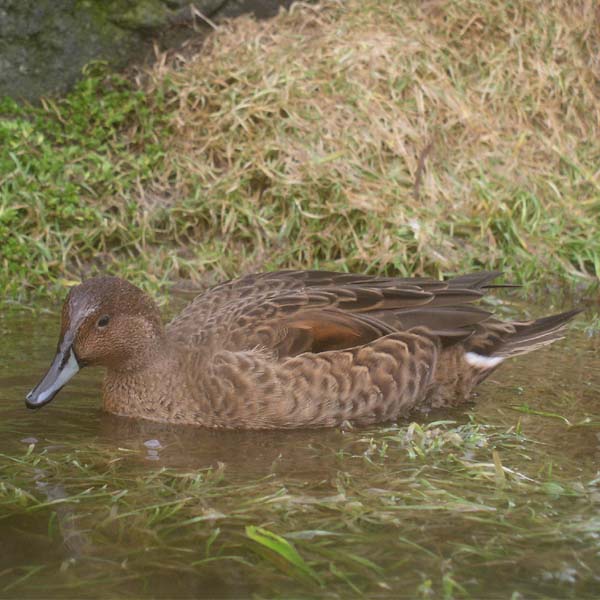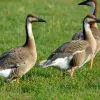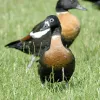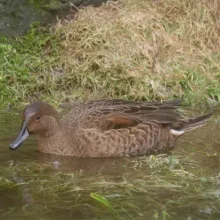
Eaton's pintail (Anas eatoni eatoni)
Species name
- Dutch name:
- Eaton's pijlstaart
- English name:
- Eaton's pintail
- German name:
- Kerguelenente
- French name:
- Canard d'Eaton
- Scientific name:
- Anas eatoni eatoni
Scientific classification
- Order:
- Anseriformes
- Family:
- Anatidae
- Onderfamilie:
- Anatinae
- Genus:
- Anas
Description
- Description:
Small, short-necked pintail. Resembles female Northern Pintail A. acuta, but darker overall tone, more reddish-brown, and scalloping on flanks smaller and less obvious.
Male:
Has elongated central tail feathers and green speculum bordered with white. Minority of males (1%) assume brighter breeding plumage with trace of chocolate-brown on head and whitish stripe up side of neck.Female:
Has brown speculum bordered with white. Subspecies similar but drygalskii slightly paler, more buff on breast, and some birds show fine vermiculations on lower hindneck and flanks.
Standard Measurements
- Body Length (cm):
- The male (drake) of the Eaton's pintail measures approximately 35-40 centimeters. The female measures approximately 35-40 centimeters.
- Body Weight (grams):
- The male will weight about 400-500 gram. The female will weight about 400-500 gram.
The weight is notoriously variable and can only be used as indication!
- Note:
Eaton's pintails are not commonly kept and have been bred only rarely in captivity. The nests are at some distance from each other and are built in grass and low soil vegetation. Also used are rock bands near waters. The nesting well is laid out with moss and down.
- Breeding:
- The female Eaton's pintail usually lays from 5 pale olive green eggs and incubates them for 26-28 days.
- Artificial incubating:
The ideal relative humidity for incubating most waterfowl eggs is 55% (ground nesters) and 40% (cavity nesters). The temperature is usually 37.4°C. Set ventilation as recommended by the incubator manufacturer. Eggs must be turned, either automatically or by hand, a minimum of 4 times a day. As the duckling develops there is a loss of water from the egg and the air sac gets bigger. In normal development of an egg with a 26-28 days incubation, the air sac occupies about a third of it three days earlier. Cleanliness is vital and ideally eggs should be moved to a separate hatcher at this point, where the humidity should be increased to 65% and even higher once they have pipped internally.
- Bird banding:
- Recommended closed leg band ring size for the Eaton's pintail is 9 mm.The leg band ring can only be applied on a young dabbling duck at around 11-12 days old.
- It doesn't matter what leg that you band, but it's good to have a consistent system. Suggested: Left leg = Female, Right leg = Male
- Maintenance food:
-





Lundi Regular with a protein content of 20%, valuable Spirulina and high-quality by-products is optimally balanced in its composition maintenance food for water ornamental fowl of all kinds. Especially green teal and Whistling ducks that are not dependent on a very high protein content, are well supplied.
Lundi Regular contains all the minerals and vitamins in full form that are important for the animals. Therefore also suitable as breeding food.





Floating full food for all sea ducks, green ducks, eider ducks and geese, especially in the moulting and breeding phase ideally suited. Packed with wholesome raw materials, natural vitamins and trace elements, this performance food with a protein content of 30% forms the basis for lifelong vitality.
